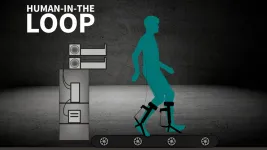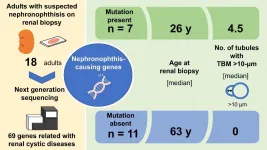(Press-News.org) Being unable to walk quickly can be frustrating and problematic, but it is a common issue, especially as people age. Noting the pervasiveness of slower-than-desired walking, engineers at Stanford University have tested how well a prototype exoskeleton system they have developed - which attaches around the shin and into a running shoe - increased the self-selected walking speed of people in an experimental setting.
The exoskeleton is externally powered by motors and controlled by an algorithm. When the researchers optimized it for speed, participants walked, on average, 42 percent faster than when they were wearing normal shoes and no exoskeleton. The results of this study were published April 20 in IEEE Transactions on Neural Systems and Rehabilitation Engineering.
"We were hoping that we could increase walking speed with exoskeleton assistance, but we were really surprised to find such a large improvement," said Steve Collins, associate professor of mechanical engineering at Stanford and senior author of the paper. "Forty percent is huge."
For this initial set of experiments, the participants were young, healthy adults. Given their impressive results, the researchers plan to run future tests with older adults and to look at other ways the exoskeleton design can be improved. They also hope to eventually create an exoskeleton that can work outside the lab, though that goal is still a ways off.
"My research mission is to understand the science of biomechanics and motor control behind human locomotion and apply that to enhance the physical performance of humans in daily life," said Seungmoon Song, a postdoctoral fellow in mechanical engineering and lead author of the paper. "I think exoskeletons are very promising tools that could achieve that enhancement in physical quality of life."
Walking in the loop
The ankle exoskeleton system tested in this research is an experimental emulator that serves as a testbed for trying out different designs. It has a frame that fastens around the upper shin and into an integrated running shoe that the participant wears. It is attached to large motors that sit beside the walking surface and pull a tether that runs up the length of the back of the exoskeleton. Controlled by an algorithm, the tether tugs the wearer's heel upward, helping them point their toe down as they push off the ground.
For this study, the researchers had 10 participants walk with five different modes of operation. They walked in normal shoes without the exoskeleton, with the exoskeleton turned off and with the exoskeleton turned on with three different modes: optimized for speed, optimized for energy use, and a placebo mode adjusted to make them walk more slowly. In all of the tests, participants walked on a treadmill that adapts to their speed.
The mode that was optimized for speed - which resulted in the 42 percent increase in walking pace - was created through a human-in-the-loop process. An algorithm repeatedly adjusted the exoskeleton settings while the user walked, with the goal of improving the user's speed with each adjustment. Finding the speed-optimized mode of operation took about 150 rounds of adjustment and two hours per person.
In addition to greatly increasing walking speed, the speed-optimized mode also reduced energy use, by about 2 percent per meter traveled. However, that result varied widely from person to person, which is somewhat expected, given that it was not an intentional feature of that exoskeleton mode.
"The study was designed to specifically answer the scientific question about increasing walking speed," Song said. "We didn't care too much about the other performance measures, like comfort or energy. However, seven out of 10 participants not only walked faster but consumed less energy, which really shows how much potential exoskeletons have for helping people in an efficient way."
The settings that were optimized specifically for energy use were borrowed from a previous experiment. In the current study, this mode decreased energy use more than the speed-optimized settings but did not increase speed as much. As intended, the placebo mode both slowed down participants and boosted their energy use.
Better, faster, stronger
Now that the researchers have attained such significant speed assistance, they plan to focus future versions of the ankle exoskeleton emulator on reducing energy use consistently across users, while also being more comfortable.
In considering older adults specifically, Collins and his lab wonder whether future designs could reduce pain caused by weight on joints or improve balance. They plan to conduct similar walking tests with older adults and hope those provide encouraging results as well.
"A 40 percent increase in speed is more than the difference between younger adults and older adults," said Collins. "So, it's possible that devices like this could not only restore but enhance self-selected walking speed for older individuals and that's something that we're excited to test next."
INFORMATION:
Young scientists of Tomsk Polytechnic University as a part of the team of Arctic researchers have studied pore waters in three areas of methane release on the surface. They first managed to define in details the composition of pore waters in the cold methane seeps of the Eastern Arctic seas. The research findings are published in the Water academic journal.
The research was based on the samples obtained during the Arctic expedition aboard the research vessel "Akademik Mstislav Keldysh" in 2019. The scientists and students from 12 scientific institutions, including Tomsk Polytechnic University, Moscow Institute of Physics and Technology, Lomonosov Moscow State University, the Research Center of Biotechnology ...
The Environmental Protection Agency (EPA) largely remedies Superfund sites containing asbestos by capping them with soil to lock the buried toxin in place. But new research suggests that this may actually increase the likelihood of human exposure to the cancer-causing mineral.
"People have this idea that asbestos is all covered up and taken care of," said Jane Willenbring, who is an associate professor of geological sciences at Stanford University's School of Earth, Energy & Environmental Sciences (Stanford Earth). "But this is still a lingering legacy pollutant ...
Sugar is not just something we eat. On the contrary. Sugar is one of the most naturally occurring molecules, and all cells in the body are covered by a thick layer of sugar that protects the cells from bacteria and virus attacks. In fact, close to 80 per cent of all viruses and bacteria bind to the sugars on the outside of our cells.
Sugar is such an important element that scientists refer to it as the third building block of life - after DNA and protein. And last autumn, a group of researchers found that the spike protein in corona virus needs a particular sugar to bind to our cells efficiently.
Now the same group of researchers have completed a new study that further digs into the cell receptors to which sugars and thus bacteria and virus ...
Researchers at Tokyo Medical and Dental University (TMDU) in a pioneering study identify clinical, genetic and histopathological characteristics that may help confirm the diagnosis when nephronophthisis occurs in adults
Tokyo, Japan - Nephronophthisis (NPH) is a kidney disease affecting mainly children. Now, for the first time, researchers at Tokyo Medical and Dental University (TMDU) have studied a number of adults with NPH and highlighted clinical, genetic and pathological characteristics that could help in confirming this challenging diagnosis.
NPH is inherited in an autosomal recessive pattern and, though rare, is the commonest genetic cause of kidney failure in children. The ...
It is 2,250 kilometers long, but only 355 kilometers wide at its widest point - on a world map, the Red Sea hardly resembles an ocean. But this is deceptive. A new, albeit still narrow, ocean basin is actually forming between Africa and the Arabian Peninsula. Exactly how young it is and whether it can really be compared with other young oceans in Earth's history has been a matter of dispute in the geosciences for decades. The problem is that the newly formed oceanic crust along the narrow, north-south aligned rift is widely buried under a thick blanket of salt and sediments. This complicates direct investigations.
In the international journal Nature Communications, scientists from GEOMAR Helmholtz Centre for Ocean Research Kiel, ...
Tsukuba, Japan - Blood vessels can be injured by the build-up of atherosclerosis and long-standing hypertension, among other conditions. As a consequence, blood vessels may undergo a process called remodeling, whereby their walls thicken and cause blockages (known as occlusion). In a new study, researchers from the University of Tsukuba discovered how cells marked by platelet-derived growth factor receptor alpha (PDGFRa+) residing predominantly in the most outer layer of blood vessels contribute to their remodeling.
Blood vessels comprise three layers, each of which fulfills a unique role ...
Single-molecule fluorescence detection (SMFD) is able to probe, one molecule at a time, dynamical processes that are crucial for understanding functional mechanisms in biosystems. Fluorescence in the Near-infrared (NIR) offers improved Signal to Noise Ratio (SNR) by reducing the scattering, absorption and autofluorescence from biological cellular or tissue samples, therefore, provides high imaging resolution with increased tissue penetration depth that are important for biomedical applications. However, most NIR-emitters suffer from low quantum yield, the weak NIR fluorescence signal makes the detection extremely difficult.
Plasmonic nanostructures are capable of converting localized electromagnetic energy into free radiation ...
Strawberry geranium (Saxifraga stolonifera) has been used in Japan as a herbal medicine to treat wounds and swelling, and continues to be an ingredient in food and cosmetics. Pharmacological studies have shown that extracts of strawberry geranium have antioxidant and antitumor activities. However, the anti-inflammatory effect of strawberry geranium on the skin had not been well characterized.
This study, first-authored by associate professor Takeshi Kawahara of the Institute of Agriculture, Shinshu University for a joint research project with Maruzen Pharmaceutical Co., ...
Dr. Sabrina Coninx from Ruhr-Universität Bochum and Dr. Peter Stilwell from McGill University, Canada, have investigated how philosophical approaches can be used to think in new ways about pain and its management. The researchers advocate not merely reducing chronic pain management to searching and treating underlying physical changes but instead adopting an approach that focuses on the person as a whole. Their work was published online in the journal "Synthese" on 15 April 2021.
It is not currently possible to treat chronic pain effectively in many cases. This has encouraged researchers from various disciplines to consider new approaches ...
A team led by Prof. GUO Guangcan and Prof. ZOU Changling from the University of Science and Technology of China of the Chinese Academy of Sciences realized efficient frequency conversion in microresonators via a degenerate sum-frequency process, and achieved cross-band frequency conversion and amplification of converted signal through observing the cascaded nonlinear optical effects inside the microresonator. The study was published in Physics Review Letters.
Coherent frequency conversion process has wide application in classical and quantum information fields such as communication, detection, ...




